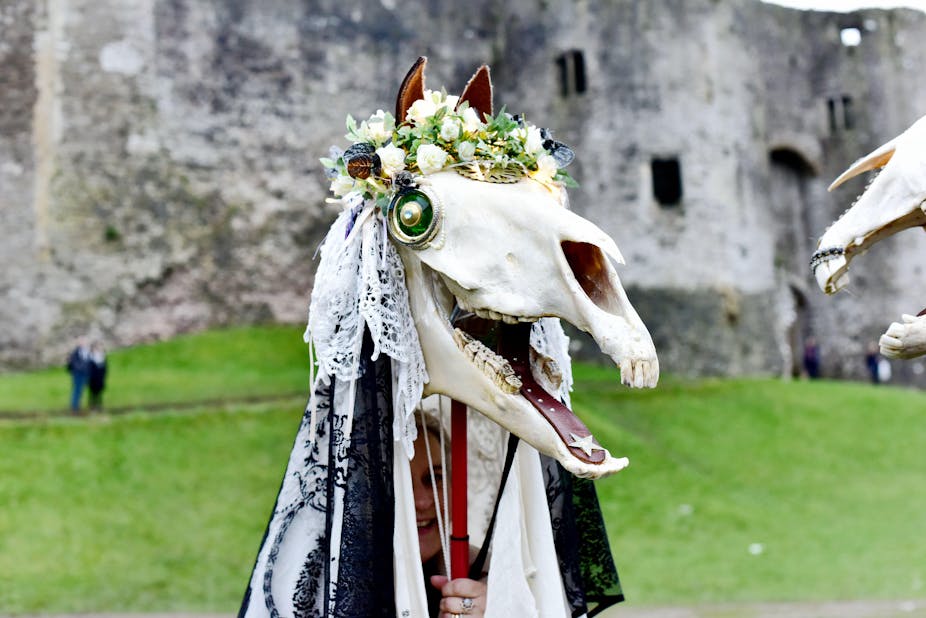Imagine you’re having a quiet evening at home when suddenly there’s a knock on the door. You open it to find a boisterous crowd carrying a horse’s skull mounted on a pole and draped in ribbons – the Mari Lwyd has arrived.
The Mari Lwyd, meaning “grey (or pale) mare”, is a Christmas and new year custom in areas of south Wales dating back to the 18th century. A horse’s skull is placed on a pole and covered in a white sheet, decorated with ribbons. A person, concealed under the sheet, carries the pole and operates the horse’s jaw, making it snap. A group of stock characters accompany them including Sergeant, Merryman, Punch and Judy.
The procession goes from house to house and the group sing verses asking for admittance. The household is expected to respond, also in verse. And so begins a (sometimes very long) improvised poetic contest or rhyming ritual known as pwnco before the group is finally invited into the house and offered food and drink.
Several explanations have been proposed as to the origin of the custom. Some argue that its roots lie in a pre-Christian fertility ritual. Others have argued that the Mari Lwyd has associations with the Virgin Mary.
The custom is clearly connected to the practice of wassailing, where groups of merrymakers go from one house to another asking for food and drink. It may be linked to other folk performances found elsewhere in Britain and Ireland, including the hobby-horse tradition.
Plygain
Further north, a tradition celebrated in Montgomeryshire, where I was brought up, is much less colourful and firmly located within a religious context. Deriving from the Latin “pullicantio” (cock crow), the plygain (pronounced “plug-ine”), was an early-morning service originally held on Christmas Day in parish churches and then also in nonconformist chapels, beginning in candlelight and continuing into daylight.
It is now mainly an evening service, although some stalwarts still adhere to the early morning tradition.
After a congregational hymn, a reading and a prayer, the vicar or minister will announce, “Mae’r blygien yn awr yn agored” (the plygain is now open). There is no programme; rather, a party of singers will get up and make their way to the chancel or the sêt fawr (the elder’s pew in a chapel), and sing a carol, unaccompanied and with no conductor.
These are often from the same family and with an ancient pedigree, their frayed carol books (usually old notebooks) having been passed down through the generations. A tuning fork is often used to pitch the tune – I’ve even seen it struck against a singer’s tooth.
The carols would often have been composed by local poets and sung to popular tunes of the time. They do not describe solely the birth of Christ and frequently focus on the crucifixion. Often very long, they are usually sung in three-part harmonies.
The plygain ends with the spine-chilling sound of Carol y Swper (the Supper Carol), when all the men in the congregation come forward to sing.
Revival and reinvention
In the 1960s, the St Fagans National Museum of History, or the Welsh Folk Museum as it was then known, began collecting different genres of Welsh folk songs. These included plygain carols and Mari Lwyd verses. This has helped to renew interest in both traditions.
The museum hosts annual Mari Lwyd performances, while many a Cardiff pub-goer will likely be startled by the sudden appearance of a snapping horse’s skull. The practice has evolved over time – visits can be pre-arranged, participants will sing from song sheets, the Mari may even be made of cardboard. In fact, anything goes.
Today, the Mari (in various guises) is thriving, and can be found as far afield as the USA and Australia.
The plygain is still going strong in Montgomeryshire and, indeed, all over Wales and beyond. Around 50 services are held during December and January.
And this tradition, too, has undergone many changes. Several collections of plygain songs have by now been published enabling new carollers to participate.
In 2020 and 2021, a virtual plygain took place during the pandemic. A bilingual plygain website has also been set up and a new carol composed specifically for women’s voices, so that women, too, have their Carol y Swper.
Purists would argue that traditions should not be revived and re-invented. But it is in the nature of traditions to change and constantly evolve – they must do so in order to survive.
We should continue to celebrate the modern-day versions of the Mari Lwyd tradition and the plygain because they contribute to a shared sense of identity and instil in participants a sense of belonging.

